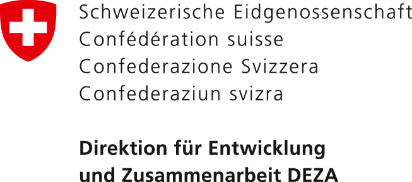From the earth and back to the earth
The Federal Institute of Technology in Zurich (ETH) has adopted a cross-cutting approach to support a circular economy project to improve food security and living conditions in the urban areas around four African cities.

«I was milling cassava when suddenly the power cuts for an hour. It didn't make me happy because I had given myself a target to achieve. That is why I look sad in this picture.»
Thierry Shyaka
In Africa, lack of job opportunities, climate change and social conflicts drive people from rural to urban areas where they hope to build a new life. Many of them end up in informal settlements where food insecurity is high.
The ETH supports the RUNRES project with financial assistance from the SDC. The project aims to develop a circular economy in four second-tier African cities and create jobs associated with the valorisation of organic waste. "Our aim is to improve living conditions, resilience and food security in peri-urban areas," says Leonhard Späth, a post-doc student at the ETH. "Our concept is to recycle organic waste and use it to produce compost and animal feed. Essentially, what comes from the earth must go back to it."
Developing local solutions
By focusing on circularity, RUNRES aims to make regional food systems more sustainable in the urban areas around Kamonyi (Rwanda), Arba Minch (Ethiopia), Bukavu (Democratic Republic of the Congo) and Msunduzi (South Africa). The project has adopted a cross-cutting approach and involves the population, local partners and universities in these four cities. "We did not import solutions to Rwanda, we developed them locally," says Späth. "Together we determined the needs, collated the required socioeconomic information and identified the best technical innovations." RUNRES was launched in 2019 and will be implemented in two phases. The first phase ends in August 2023 while the second will conclude in August 2027.
In Rwanda, for example, toilets which separate urine and faeces have been installed so that the urine can directly be used as fertiliser. New technology also allows cassava peels to be used for feed production. "They used to be considered a nuisance and discarded because they are toxic when raw," explains Späth. By using a press for removing most of the water in the peels and drying them in the sun, they can be processed into flour and used as animal feed. Elsewhere, larvae of the black soldier fly are grown, which feed on organic waste. After about two weeks, in the last larval stage, they become a source of high-protein feed for poultry.

«I bought this goat from my savings. She is pregnant and can have up to four baby goats.»
Protogene Nyandwi

«I don’t like this organic waste which I have to feed to the larvae. It smells horrid and sometimes it contains sharp and pointed objects which cut my hands.»
Julienne Uwase

«Never get upset about your job, whether you like it or not. You can only be happy because a bad job helps you get a good one.»
Ismael Muneza

«I’m smiling in this picture because I am happy when I get paid at the end of the day. With the money I can buy school materials for my kids, food and lotion.»
FÉlicitÉ Nyirahabineza

«I like this job because this is what I do most of the time. I also like working with others. When I am alone, I think too much about things that are not going well.»
Alphonsine Muhawenimana (second from right)
A picture is worth a thousand words
As part of her doctoral thesis at the ETH, Mélanie Surchat asked 17 people who work in waste recycling to illustrate their positive and negative experiences with the RUNRES project in Rwanda using four of their own photographs. Her interest was to understand and describe a job in organic waste recycling from a worker’s perspective. "I believe that each individual should be given the opportunity to portray themselves and narrate their own story," explains Surchat. "I wanted to shed my colonial baggage as a white academic, whose perception and depiction of Africa is historically shaped, and give the people the chance to visually convey what is important to them." After the participants had taken their photographs, they each explained what they associated with the photos in a detailed interview conducted in Kinyarwanda. The research project was conducted using the photovoice method and culminated in a virtual exhibition with pictures and quotes from the interviews.
We look forward to your visit. Further Information




